I have been interested in the opportunity for higher education infused urban revitalization for decades.
In DC, for awhile I was a Main Street manager in the Brookland neighborhood, which is home to Catholic University, Trinity Washington University and near Howard University, and I touted the potential of student spending as an element of commercial district revitalization.
Student spending. The problem with that is students spend money in very narrow ways. At the time those universities were interior focused and I promoted the idea of moving the CUA bookstore to 12th Street NE. (Howard does have its bookstore on Georgia Avenue and they tried for a hotel and have worked on developing a town center there for a couple decades).
That didn't happen, but did with an campus adjacent development--Monroe Street Market--on land owned by CUA, but creating a competing retail center against the 12th Street commercial district, which still limps along today, 10 years after the opening of Monroe Street Market.
Students spend most of their money on food and drink, books, and sundries. You need a lot more students than CUA (6,700) or Trinity (1,800) to have a real impact on a local commercial district.
I went to the University of Michigan, which has a two major retail districts abutting the campus (and a couple of other little ones). But these days, UM has 51,000 students--it was the low 30,000s when I went there.
Businesses developed out of university-based research. Another element is business spinoffs from university-based research--medical, pharmaceutical, engineering, business, IT. DC's universities aren't particularly good at that either, although some does happen, but the businesses usually end up in the suburbs, where there is more of a business ecosystem, and/or is where the principals live.
Faculty concentration as talent and an element of community development. Faculty creating a cluster, having bright children in schools, supporting community institutions, etc., is another element of community revitalization, especially of schools, but the faculty at DC's colleges don't seem to be clustered, at least not in the way that NIH staff children have on Montgomery County schools.
Real estate development. Some schools have invested in nearby commercial districts, like Catholic University mentioned above. The University of Connecticut ("
UConn Decides to Build Its Own College Town,"
New York Times) and University of Maryland are trying to create town centers which otherwise don't exist. Ohio State University has a major investment program in the
High Street district.
University of Pennsylvania and Mercer University in Macon, Georgia have invested in neighborhood revitalization, and many colleges have special mortgage financing programs for faculty and staff which help to bring faculty close to the campus. George Washington University owns a huge amount of commercial property around its campus, which is a major source of revenue. Yale University too is a big factor in New Haven real estate. Etc.
The Lincoln Land Institute has a program working with universities on this.
Unrelatedly, Ann Arbor, where the University has grown its enrollment by more than 50% in the past 40 years, is undergoing an intensification that is a national outlier, with many small scale buildings in the core of the city being sold, demolished and replaced with multistory buildings.
Interestingly, DePaul University, known for basketball, with subsidy from Chicago, built a new arena off campus in the Convention Center district. Some cities like Waco for Baylor University, have provided financial support for college football stadiums and arenas. There is such a project right now in Kalamazoo, Michigan for a mixed use facility that will have Western Michigan University teams as anchor tenants ("
Plans revealed for new arena in downtown Kalamazoo,"
Kalamazoo Gazette).
The question becomes: what kinds of schools are good at stoking revitalization? I remember when I went to UM, Eastern Michigan University in next door Ypsilanti was touted for moving their business school to the Downtown. When I applied for a job in Hyattsville, I suggested they try to get University of Maryland to move their Art School to the Route 1/Rhode Island Avenue corridor, to anchor the Gateway Arts District. The University of Tennessee moved its architecture school to Downtown Knoxville. And the GMU campus at Virginia Square in Arlington, Virginia, which has the policy and law schools, and other programs.
EMU and ASL haven't had much impact. I don't know about UT. And people aren't calling Arlington a college town.
Commuter school versus residential campus versus "night school" versus semester in X city program. Besides how big the school is, a goodly part of this comes down to the nature of the program. Residentially-based schools are likely to have more economic impact on local stores, while commuter and night school students are likely to spend minimal time on campus or in nearby commercial districts outside of class.
Leveraging higher education institutions for urban economic development. It is possible to leverage higher education institutions in important ways. But it needs to be purposive. Trickle down doesn't work that well. I've written about it a lot:
Making the point that DC in particular doesn't seem to be very good at it.
District officials have spent months figuring out how to counter negative economic trends spurred by emptied offices downtown. But their efforts to repopulate the area are set to get a big boost from the University of Southern California — which on Wednesday unveiled its East Coast campus, in the heart of D.C.’s business district.
USC’s “Capital Campus” will transform the 60,000-square-foot, crescent-shaped building at 1771 N St. NW, previously occupied by the National Association of Broadcasters, into a home base for students and graduates of the Los Angeles-based university. The official opening places USC among a growing array of universities with hubs in the District, giving students a chance to capitalize on political and policy-based career opportunities that have become synonymous with Washington.
USC President Carol Folt says the hub could draw nearly 1,000 of the university’s students to D.C. each academic term, potentially tripling or quadrupling the university’s presence in the city. For D.C. Mayor Muriel E. Bowser (D), who toured the facility with Folt on Tuesday, that prospect fits squarely into her administration’s plan to “reimagine” sectors of downtown that have long been associated with large office buildings and the working professionals within.
It's a small program that won't have anywhere near the impact of the existing major schools that are already based in the city: American University (14,318 students); George Washington University (25,613 students--this includes their Virginia campus); Georgetown University (19,371 students); Howard University (10,000 students), etc. (UDC like CUA and Trinity is smaller.)
As it is there are a bunch of university centers in the city already similar to what USC is launching. What kind of substantive economic impact do they have? I know I haven't noticed much.
Plus there is Johns Hopkins University, which has had a comparable campus (a couple buildings) in Dupont Circle for decades and is moving to the former Newseum ("
Former Newseum almost ready for Johns Hopkins graduate students" WTOP radio)--and that's a 420,000 s.f., project, and it seems as if they'll also run the Dupont Circle buildings for awhile. It opens this fall.
Conclusion. To be clear, I think programs like the new one by University of Southern California are great, and that cities like DC should be open to them. I'm just turned off by the puffery.
I find DC's planning around higher education to be pretty disappointing. But that's not a unique failing. DC's planning function and capacity has diminished with each mayor since Anthony Williams left office in 2006. (Maybe it was in stasis under Mayor Gray.)
Cities like Greensboro or Portland or Spokane have to be more innovative because they have fewer opportunities.
DC has plenty of assets. They aren't coordinated or leveraged very well. And that's where the local government planning functions have opportunities.
DC needs to be more innovative to be able to develop its economy semi-independently of the federal government, which was slow and steady and growing for decades, but now no longer is, especially with the impact of what is now called work from home (formerly called telecommuting) post covid.
Instead, under Mayor Bowser DC's urban and economic planning functions have stagnated.



4 Comments:
Johns Hopkins opens new D.C. academic center in an old museum site
https://www.washingtonpost.com/education/2023/10/06/johns-hopkins-dc-building-government-school/
“What this represents is the physical manifestation of the university’s commitment to national and international engagement,” Ronald J. Daniels, the Hopkins president, said this week during a tour of the space. “The idea was to create a place for the university in Washington proximate to power.”
Many have the same idea. The University of Southern California announced in March the purchase of a building near Dupont Circle for a new D.C. campus. Among numerous others operating in and near downtown Washington are New York University, Texas A&M University, Arizona State University and the University of California.
These outposts provide a venue for visiting scholars, graduate students and undergraduates aiming to research the government and related topics or work in internships on Capitol Hill and elsewhere. They bring thousands of young people into the city every year, joining those enrolled at Howard, George Washington, Georgetown, Catholic, American and Trinity Washington universities and the University of the District of Columbia.
A new report says college freshman enrollment is down across the country. Here's what that means for Pittsburgh-area colleges.
https://www.post-gazette.com/news/education/2023/11/18/national-student-clearinghouse-freshman-enrollment-pitt-iup-duquesne-slippery-rock/stories/202311160147
I seem to have forgotten to include this cite.
Colleges Have Been a Small-Town Lifeline. What Happens as They Shrink?
https://www.nytimes.com/2023/03/13/business/economy/college-towns-economy.html
Cal State Fullerton’s new president, Ronald Rochon, looks to push students to success
https://www.ocregister.com/2024/12/07/cal-state-fullertons-new-president-ronald-rochon-looks-to-push-students-to-success
Post a Comment
<< Home